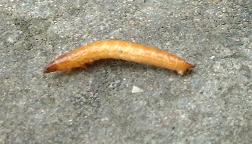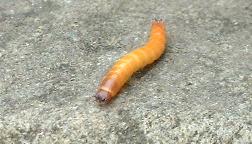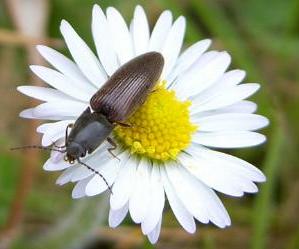Shiny, yellowish-orange, stiff-bodied
and up to 25mm long, they spend four years in the
ground before pupating for three weeks and emerging
in the summer as adult Click Beetles.


Just behind the darker head are three pairs of legs
They feed on
plant roots and bases of stems ruining potato and
other root crops, making tunnels about 3mm in
diameter which can later be invaded by slugs or
millipedes. Lift maincrop potatoes before September,
when the main damage is done. In the lawn they can
weaken the grass, but are not usually a problem. They
are usually widespread in grassland so will be found
when it is brought into cultivation. After about five
years of cultivation they usually disappear.

 The three views on the left show a Click Beetle (larger than life), the one on the right is the posture with its legs and antennae folded under the body, before it "clicks". The picture on the right shows the size relative to a daisy flower.
The three views on the left show a Click Beetle (larger than life), the one on the right is the posture with its legs and antennae folded under the body, before it "clicks". The picture on the right shows the size relative to a daisy flower.The adult Click Beetles are brown and
elongated, about 15mm long, feeding on pollen, nectar
and on the tissues of leaves and flowers. When
overturned they arch and as the abdomen and thorax move projections on each segment slip past each other causing
the body to flex propelling it into the air with a
"clicking" sound.
After mating the female lays its eggs
in weedy ground in May and June which hatch into the larval, wireworm stage.
Treatments
Lift crops from infested ground as soon as they mature to avoid damage.
Traps can be made using chunks of potato buried in the ground attached to skewers for easy removal; hopefully the wireworms tunnel into the potato which is then picked up and destroyed.
For a biological control the nematode Heterorhabditis megadis will attack wireworms. It is temperature sensitive so can only be used when the soil is at or above 12 C. The best time to apply is in August or September when the wireworms are hatching. Application may have to be repeated the following year due to the long lifecycle of the worms.
An infection of a fungus called Metarhizium anisopliae is known to kill both adult Click Beetles and wireworms so is being evaluated as a boilogical control. |
|
Back to GARDEN CREATURES



